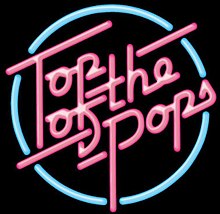
To those of us whose day it was, for so many years all human existence revolved around Thursday evenings and the thirty-minute broadcast on BBC1 which brought us news of all the latest movements from the UK singles’ charts. Whichever football team one supported, which school one went to – Top of the Pops was the totem around which all of adolescent humanity danced. During the week we may have moved in different circles, had different interests and hung out in different places, but seventies’ youth was united in its knowledge of which act was at Number One with which song, how many new entries had penetrated the Top Thirty and what our heroes had worn during their latest appearance, usually down to the finest detail. TOTP was not a TV programme, it was a national institution for which a lack of appreciation was indicative of some irreversible and incurable detachment from meaningful life itself.
Launched on 1st January 1964 to the sound of Dusty Springfield’s I Only Want to Be With You, the programme had only originally been envisaged as a short-term project. But by the time the weekly show was finally wound up on 30th July 2006 it had broadcast 2,263 episodes alongside its fondly-awaited bumper Christmas, New Year and Comic Relief specials.
Glam rock movement
For many the heyday of TOTP was the seventies, and the appearance of a tinselled and sequinned Marc Bolan and T. Rex performing Hot Love in March 1971 is widely credited as having given birth to the glam rock movement which dominated the early part of that decade. We had our own boy bands too, with the Osmonds and the Jackson Five enjoying a fierce if friendly rivalry as they captured the hearts of many, whilst Donny Osmond competed with David Cassidy for the innocent affections of the day’s teen and even pre-teen girl fans.
The format was simple, but extraordinarily effective. Following a brief introduction from the host a long series of one-second stills would chart that week’s Top 30 in reverse sequential order to the sound of Led Zeppelin’s Whole Lotta Love as performed by C.C.S., culminating in the excited revelation of that week’s chart topper. The show would then feature several acts appearing in the studio (all of which would be in the ascendancy), a clip or two from artists who couldn’t make the gig but whose contributions were nevertheless considered to be relevant, and the resident (usually scantily-clad) female dance troupe strutting their stuff to one additional number – Pan’s People and Legs & Co. being perhaps the most memorable. The climax of the show would be the inevitable performance of the Number One act, before an outro terminated rudely in its prime would abruptly herald the end of that week’s cultural offering.
A unique experience
The Top of the Pops studio was a unique experience in so many ways. The presenter, usually a popular radio DJ of the period, would be surrounded by a hundred or so young guests who would dance to each song with widely varying degrees of competence and enthusiasm (I recall the sense of excitement we all shared at our school when one of our classmates got to attend the big event).
If the song sounded uncannily faithful to the original recording (which those of us who were truly in with the in-crowd would already have bought and played to death by the time it first made the show), there was a very good reason for this. For various, mainly logistical reasons many of the tunes had to be mimed, a demand not always appreciated by the players themselves. Those who refused often turned out memorable performances, David Bowie’s famously powerful delivery of his hit The Jean Genie being one of the most notable. Others chose instead to do so under protest, registering their discontent in a number of imaginative and amusing ways. Musicians from Frankie Goes to Hollywood swapped instruments, Oasis and The Communards switched lyricists, whilst a technical blunder left a bemused Jimi Hendrix with the unenviable task of having to pretend to be Alan Price singing The House That Jack Built. Whether it was an anti-miming protest or not, the mental image of Dexy’s Midnight Runners belting out Jackie Wilson Said (I’m in Heaven When You Smile) in front of a backdrop photo of Scottish darts legend Jocky Wilson is probably one of the most enduring ever thrown up by the long-running show.
In 1978 The Rezillos enjoyed chart success with their hit Top of the Pops, in which they lampooned the ethos of the show, appearing on it twice to perform their new number without any apparent sense of irony.
Fond memories
Retrospectively, the fond memories that many of us have of this iconic television show are destined to remain tainted by the proclivities of certain of its most significant personalities. During 1972 and 1973 nobody commanded the stage with more power and gusto than Gary Glitter, who belted out hit after foot-stomping hit, many of which came straight into the charts at Number One on their first week of release. And a huge gap inhabits the archives now the chroniclers have completed the unenviable task of removing all the clips or episodes featuring the monstrously ubiquitous sexual abuser Jimmy Savile. At times I feel dirty, not to mention strangely cheated, whenever I look back upon the joy that that seemingly innocent thirty minutes used to bring to me each and every week.
The secret to the success of Top of the Pops, later discredit notwithstanding, lay in the fact that it was at the time one of the only ways through which to enjoy the music of the day. There was no internet, no downloads, no instant access to sound and vision provided by YouTube or Spotify. Unless one had invested hard-earned paper round money in vinyl, the sound of that week’s top hit was elusive between Thursdays unless one had the time and patience to switch on the transistor and wait for its turn to be played.
All good things, alas, come to an end, and after years of falling ratings brought about by the advent of TV streaming and the emergence of a wholly different culture when it came to receiving and enjoying music, the BBC finally pulled the plug in 2006. The last act to appear live in the studio was Snow Patrol, performing Chasing Cars, after which the final episode used archive footage to pay tribute to some of the greatest acts to have featured on the programme during its 42 years. An old clip was shown of The Rolling Stones – the first band ever to have appeared on TOTP – playing, fittingly, The Last Time.
The studio lights were switched off and an era, which in truth had probably long passed already, was laid formally to rest.

If you enjoyed reading this article, make sure you stay updated with all Phil’s latest blog posts by signing up to receive his free Newsletter. You can unsubscribe at any time and your details will never be shared with any third party. Click here to sign up today.